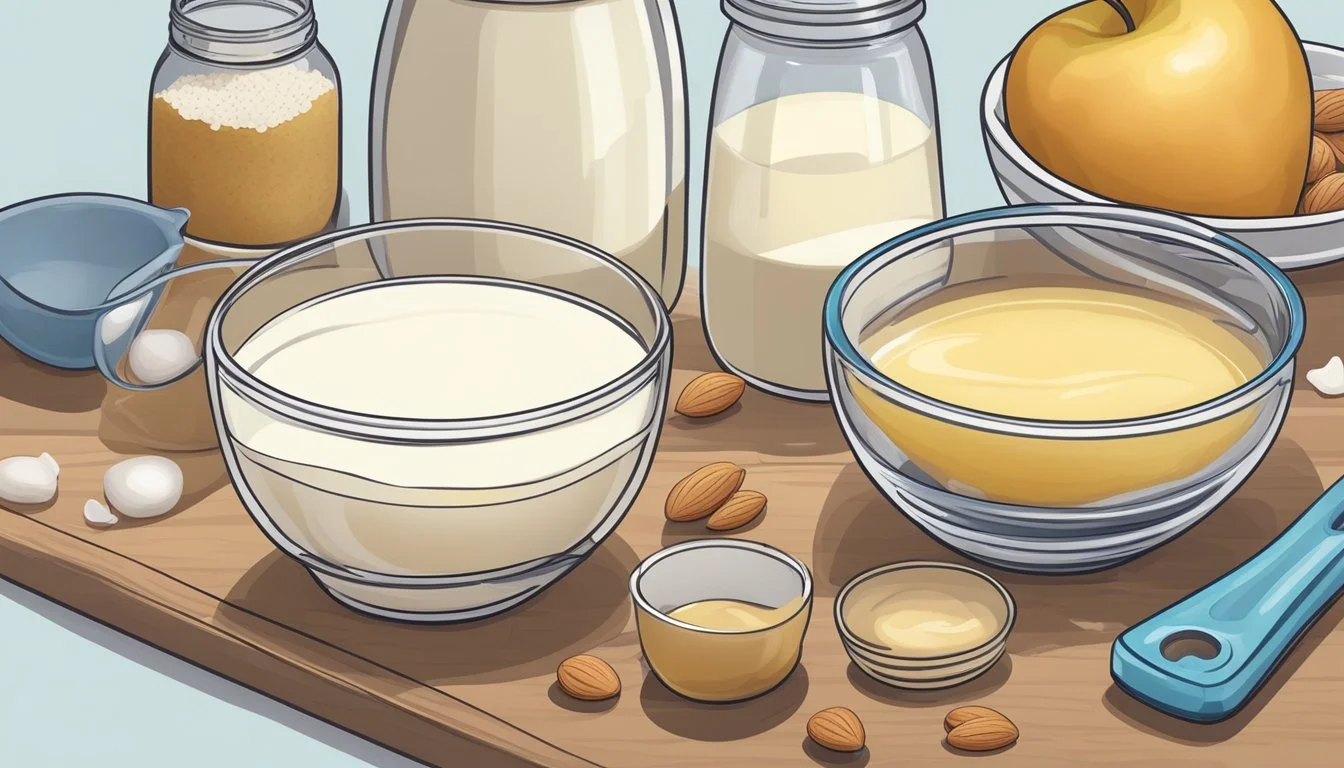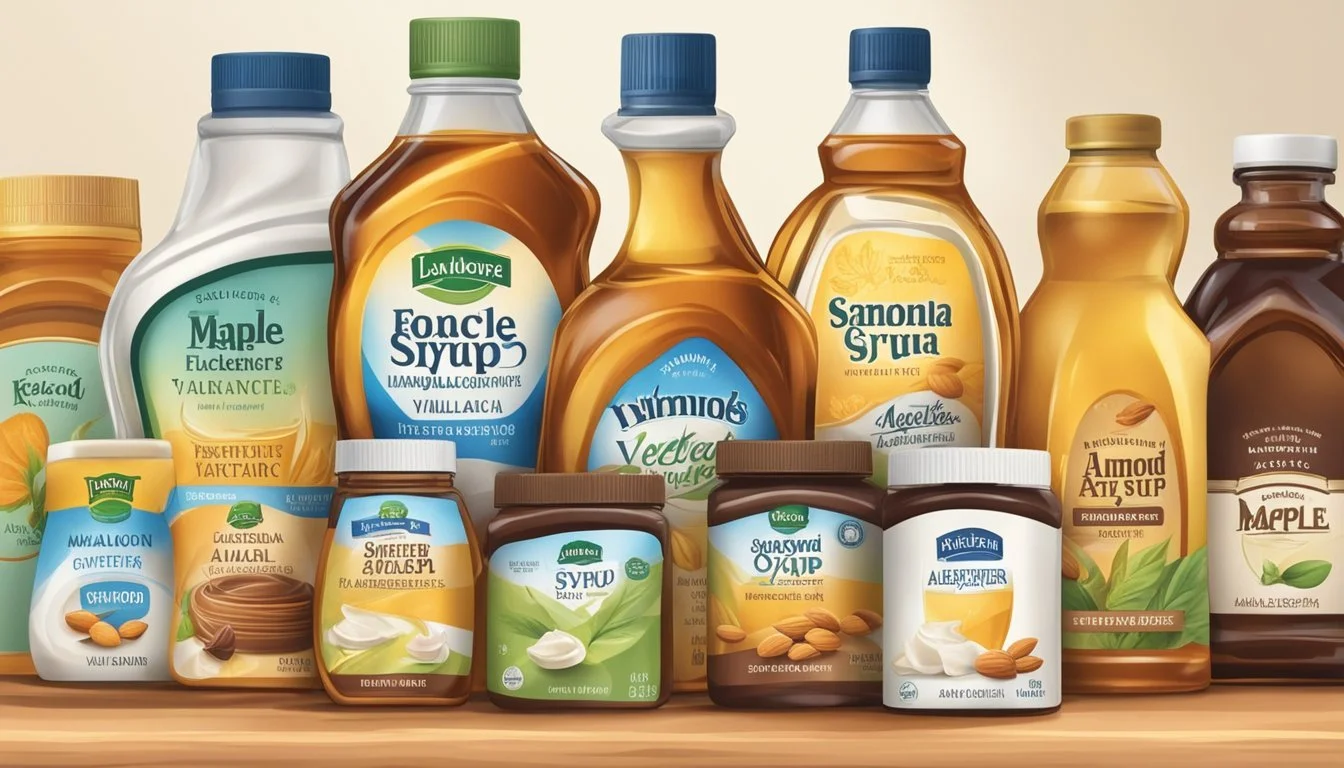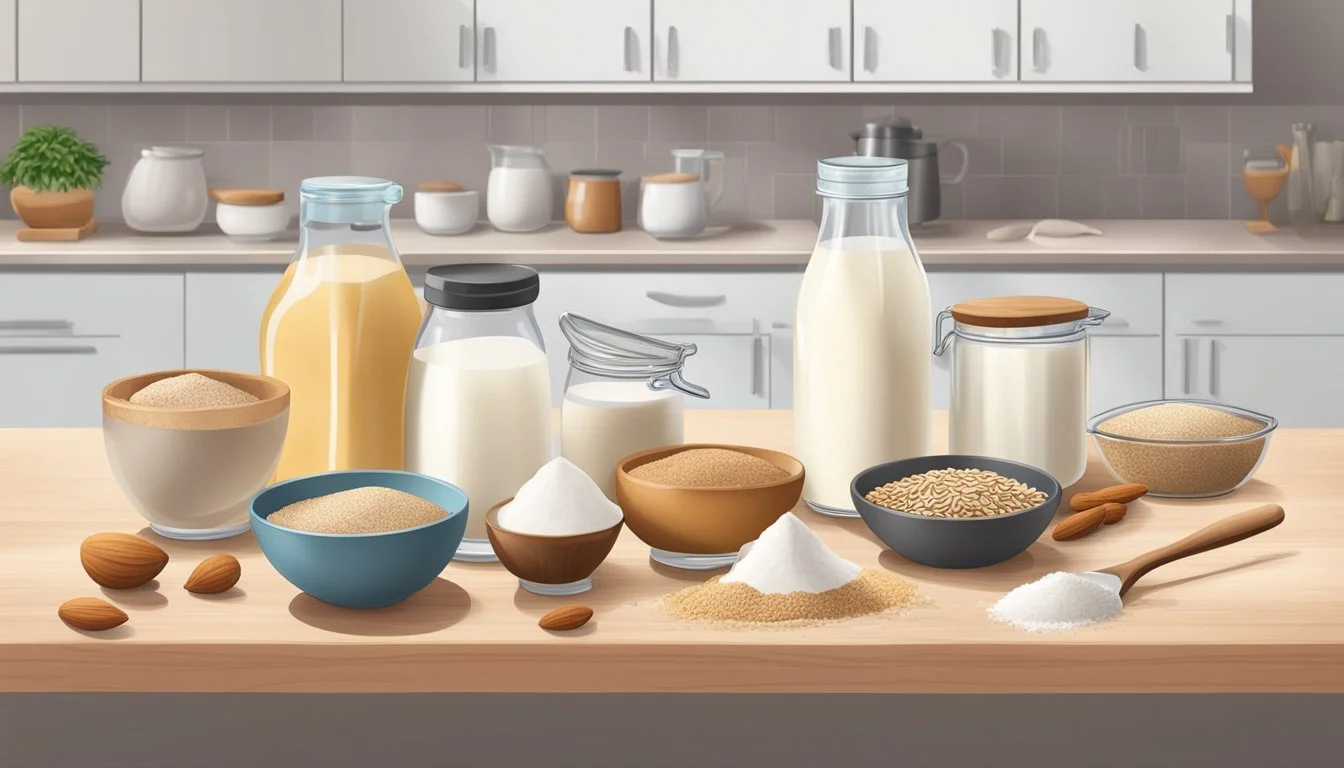What are Some Lactose-Free Baking Substitutes?
Top Alternatives for Dairy-Free Treats
For individuals with lactose intolerance or dairy allergies, as well as those who follow a vegan diet, traditional baking can pose a challenge due to the common use of dairy products. Fortunately, a variety of lactose-free and dairy-free substitutes have emerged, allowing everyone to enjoy baked goods. These alternatives not only address dietary restrictions but also offer new flavors and textures to baking.
Lactose-free milk is an immediate substitute for traditional milk and can be used in equal measure for most recipes. Non-dairy yogurts made from almond, soy, or coconut can replace whole milk or heavy cream, usually at a ratio of three quarters of a cup of non-dairy yogurt to replace each cup of milk. They offer the added benefit of a thick consistency and often contain live cultures that can enrich baked goods with a subtle tang.
Experimentation with dairy-free alternatives has led to the discovery of other suitable replacements. Coconut oil or vegetable oils can be used in place of butter, and this often imparts a moist texture to items like cakes and breads. For making dairy-free buttermilk, a tablespoon of lemon juice or apple cider vinegar can be added to a cup of nut or seed milk and left to sit for a few minutes until it curdles, mimicking the properties of traditional buttermilk. These substitutions enable bakers to create an array of delicious and inclusive treats without dairy.
Understanding Lactose Intolerance and Dairy Allergies
Lactose intolerance and dairy allergies are distinct health concerns that impact individuals' dietary choices and nutritional intake. The role of lactose in baking and the health impacts of dairy are crucial considerations for those affected by these conditions.
The Role of Lactose in Baking
Lactose, a disaccharide sugar found in milk and dairy products, serves multiple functions in baking. Its presence affects texture, browning, and flavor. For individuals with lactose intolerance—a condition where the body lacks the enzyme lactase necessary for digestion of lactose—the use of traditional dairy ingredients in baked goods can lead to discomfort and digestive issues. They may experience symptoms such as abdominal cramps, bloating, and diarrhea.
In baking, lactose contributes to the Maillard reaction, which is responsible for the golden brown crusts of baked goods. Alternatives for lactose include lactose-free milk, plant-based milks (such as almond, soy, or coconut), and non-dairy butters. These substitutes must mimic the functional properties of lactose to maintain the quality of the final product.
Health Impacts of Dairy
Dairy products provide essential nutrients, but they can also pose health challenges for individuals with dairy allergies or lactose intolerance. A dairy allergy involves an immune system reaction to the proteins in cow's milk, such as casein or whey. Symptoms can range from mild (hives, itching) to severe (swelling, breathing problems, anaphylaxis), thus necessitating the avoidance of dairy proteins in the diet.
With lactose intolerance, the issue lies in digestion, rather than the immune response. Those with this condition must manage their intake of lactose to avoid gastrointestinal symptoms, whereas individuals with a dairy allergy must avoid dairy completely to prevent potentially life-threatening reactions. Understanding the unique requirements of these conditions is essential for maintaining health and well-being while enjoying a varied and fulfilling diet.
Dairy-Free Milk Alternatives
Dairy-free milks provide a plethora of options for lactose-intolerant individuals, ensuring that everyone can enjoy baked goods. They cater to both taste preferences and dietary needs, from nut-based milks to grain and legume-derived varieties.
Nut Milks and Allergies
Nut milks, like almond milk and cashew milk, are popular dairy-free alternatives due to their creaminess and subtle flavor that doesn't overpower baked goods. However, one must be cautious as nut milks can cause allergic reactions in those with nut allergies. When using nut milks, it's crucial to consider:
Almond Milk: Offers a slightly sweet and nutty flavor; ideal for cakes and cookies.
Cashew Milk: Creamier than almond milk, it works well in desserts that require a rich texture.
It's important to choose unsweetened and unflavored versions to avoid altering the taste of recipes.
Choosing the Right Milk for Your Recipe
Selecting the appropriate non-dairy milk for a recipe is a matter of matching the milk's properties with the desired outcome of the bake. Plant-based milks vary widely in flavor, consistency, and nutritional content:
Soy Milk: A good source of protein; mimics the richness of cow's milk. Use for a neutral-flavored, moist final product.
Oat Milk: Thick and mildly sweet; suitable for heavier bakes like muffins.
Rice Milk: Light and watery; better for recipes that don’t rely on milk for fat content.
Hemp Milk: Has a stronger, nutty taste; not recommended for delicate flavors.
For recipes that call for buttermilk, adding a tablespoon of lemon juice or vinegar to any plant-based milk can mimic its acidic properties.
Butter and Oil Substitutes
When baking without dairy, a variety of plant-based oils and fats such as coconut oil, vegan butter, and shortening can serve as appropriate substitutes for butter. These alternatives provide flexibility in texture and flavor while catering to dietary restrictions.
Health Benefits of Plant-Based Oils
Plant-based oils offer significant health benefits, primarily due to their favorable fat composition. They typically contain less saturated fat and more unsaturated fats, which are considered heart-healthy. Olive oil is celebrated for its monounsaturated fats that can improve cholesterol levels and stabilize heart rhythms. Coconut oil, although higher in saturated fat, is rich in medium-chain triglycerides (MCTs), which have been associated with certain health benefits such as increased energy expenditure and a potential reduction in waist size.
Oil Type Main Health Benefit Olive Oil High in monounsaturated fats Coconut Oil Contains medium-chain triglycerides (MCTs) Other Vegetable Oils Generally lower in saturated fats
Striving for improved health, individuals may opt for plant-based oils and non-dairy butter as substitutes in recipes. Vegan butter compositions often mirror that of dairy butter, providing similar texture and flavor profiles without lactose. On the other hand, shortening delivers a neutral flavor and is entirely plant-based, making it an excellent choice for obtaining the desired consistency in baked goods. It is important to measure these substitutes accurately, as they have differing properties and may affect the outcome of the recipe.
Substitutes for Cheese and Cream
Finding suitable lactose-free substitutes for cheese and cream is possible for both cooking and baking needs. From firm and soft cheese alternatives to sour cream and cream cheese options, the variety of substitutes available can accommodate different flavors and textures required in recipes.
Firm and Soft Cheese Alternatives
For firm cheese substitutes, options like dairy-free cheese blocks made from nut milk, such as almond or cashew, are readily available. They can be sliced or shredded and are ideal for sandwiches, salads, and toppings. Nutritional yeast is another substitute that offers a cheesy flavor, perfect for sprinkling over dishes or incorporating into sauces.
Hard Cheese: Use dairy-free cheese options, typically made from soy, coconut oil, or nuts.
Soft Cheese: For a spreadable option, cashew cheese made with soaked cashews, lemon juice, garlic, and nutritional yeast mimics the texture and taste of soft cheese.
Dairy-free yogurt can be a good base for creating spreads similar to soft cheese. By draining and pressing it to remove excess moisture, one achieves a consistency similar to crumbled soft cheese.
Sour Cream and Cream Cheese Options
For a lactose-free sour cream substitute, dairy-free yogurt works well especially when it's thick and unsweetened. When mixed with a bit of lemon juice or vinegar, the yogurt takes on the tangy taste sour cream is known for.
Sour Cream: Opt for thick, plain, dairy-free yogurt mixed with lemon juice.
Cream Cheese: Vegan cream cheese, which is often a blend of processed nuts and tapioca starch, serves as a convincing alternative.
Vegan cheese, specifically designed to replace cream cheese, comes in a variety of flavors and consistencies. These products typically include a base of coconut oil, soy protein, or processed nuts and can be used in spreads, dips, and cheesecake recipes.
Egg Replacers in Baking
Choosing the right egg replacer in lactose-free baking hinges on understanding the desired texture and recognizing suitable vegan substitutes, thereby ensuring the consistency, shape, and appeal of the final product remain intact.
Matching Egg Texture for Specific Recipes
In baking, eggs impart a specific texture to the finished goods, from providing moisture to binding ingredients. Substituting eggs, therefore, requires careful consideration of the recipe's texture demands.
For cakes and muffins that rely on eggs for moisture:
Applesauce: Use 1/4 cup to replace one egg.
Mashed bananas: The same measure applies, imparting extra flavor.
In recipes necessitating the eggs' binding capability for cookies and breads:
Flaxseed: Mix 1 tablespoon ground flaxseed with 3 tablespoons water, allow it to thicken.
Where the egg's role is to provide structure to confections like custards and fillings:
Silken tofu: Puree 1/4 cup to substitute one egg, which provides the desired creamy texture without adding discernible flavor.
Vegan Egg Substitutes
Vegan egg substitutes not only forgo animal products but also cater to those seeking dairy-free baking options. The selection of a vegan egg substitute is often dictated by the recipe at hand.
Mix with water to create a gelatinous substance akin to an egg.
Well-suited for quick breads and pancakes due to its mild, nutty taste.
Psyllium Husk Powder:
Combine 1 teaspoon with 3 tablespoons of water, then allow the mixture to congeal.
Its binding properties are optimal for cakes and muffins.
Utilizing these substitutes can effectively replace eggs in various recipes while maintaining the vital aspects such as texture and consistency. It's essential to adjust the quantity of the substitute to match the properties of the egg type specified in the original recipe, whether it be a small, medium, or large egg.
Sweeteners and Flavor Enhancers
Lactose-free baking relies on various sweeteners and flavor enhancers to provide the desired taste and texture in the absence of traditional dairy products. These substitutes not only replicate the sweetness and richness that dairy often imparts but also contribute to the overall structure of baked goods.
Plant-Based Sweeteners
Coconut Milk and Coconut Cream are excellent dairy-free alternatives that provide sweetness and creamy texture. They can be used in a range of recipes from cakes to custards, closely mimicking the mouthfeel and richness of their lactose-containing counterparts.
Sweetener Description Usage Notes Maple Syrup A natural syrup with a distinct flavor. Ideal for adding moisture and rich, caramel-like sweetness to baked goods. Stevia A plant-derived sweetener with high sweetness intensity. Used sparingly due to its high potency, suitable for sugar-free recipes. Monk Fruit Sweetener Extracted from monk fruit, with no impact on blood sugar levels. A non-caloric sweetener that works well as a sugar substitute in various recipes.
Enhancing Flavors Dairy-Free
One can enhance the flavor profile of lactose-free baked goods by incorporating non-dairy components that offer robust taste. Dark Chocolate, being inherently dairy-free, imparts an intense chocolate flavor without lactose, making it an ideal ingredient for adding depth to desserts.
Dark Chocolate: A rich source of chocolatey flavor suitable for vegan and lactose-free diets.
Milk Chocolate Alternates: Dairy-free versions often utilize rice milk or almond milk to replicate the creaminess and smoothness.
When it comes to creating rich, compelling flavors without dairy, it's important to consider both substitution and incorporation. Coconut milk, with its creamy consistency, can be used in recipes to add a hint of coconut flavor while maintaining a rich texture. Maple syrup, besides sweetening, adds a signature flavor profile that can complement other ingredients in a recipe.
Utilizing these substitutes enables bakers to produce delectable, lactose-free treats that stand up to their dairy-containing counterparts in both taste and texture.
Special Considerations for Dairy-Free Baking
Adapting recipes for dairy-free baking can impact both texture and consistency. Bakers need to consider the unique properties that dairy substitutes bring to recipes.
Gluten-Free and Dairy-Free Baking
Gluten-free baking presents additional challenges when also avoiding dairy. Gluten provides the elasticity and structure in many baked goods. When both gluten and dairy are absent, finding the right balance to replicate the desired texture becomes critical. For instance, a combination of gluten-free flours can be used to achieve a satisfactory structure, while dairy-free milks and butter substitutes cater to the moisture and fat components traditionally provided by dairy.
Key Gluten-Free and Dairy-Free Ingredients:
Flours: A mix of rice, almond, and potato flours can provide a good base.
Xanthan Gum: Often added to gluten-free baking to replicate the binding quality of gluten.
Dairy-Free Substitutes: Almond, soy, and coconut milks can replace cow's milk. Vegan butter and shortening can be used in place of butter.
In recipes like almond cloud cookies, a gluten-free treat, ensuring that almond flour is finely ground can help with achieving the right consistency without the need for dairy.
Dealing with Common Baking Issues
Baking without dairy can sometimes lead to results that are less than desirable. For example, baked goods might not brown as well without the sugars present in dairy milk. To address this, one can brush their baked goods with a thin layer of dairy-free spread or plant-based oil prior to baking.
Common Issues and Solutions:
Browning: Brush with plant-based oils or dairy-free spreads to encourage browning.
Moisture: Non-dairy yogurts or buttermilk alternatives made from non-dairy milk and vinegar or lemon juice can introduce the necessary moisture.
Richness: For richness in the absence of cream, full-fat coconut milk can be a good alternative.
Dairy-free baking not only caters to dietary preferences but can also accommodate those with nut allergies by selecting nut-free milk alternatives such as oat milk. Furthermore, probiotics in non-dairy yogurts can offer health benefits, supplementing vegan recipes with nutrients that are sometimes harder to come by in dairy-free diets.
Exploring Dairy-Free Recipes
In the world of baking, the move towards dairy-free alternatives has gained significant traction. Enthusiasts and professionals alike embrace ingredients such as nut milks and seed butters to achieve the creamy textures and rich flavors traditionally provided by dairy products.
For example, almond cloud cookies, a confectionery favorite, can be reimagined without dairy. By substituting almond milk for cow's milk and using plant-based fats instead of butter, bakers can recreate this airy treat for a dairy-free audience.
The Basics:
Buttermilk: To make a dairy-free version, mix 1 tablespoon of lemon juice or apple cider vinegar with 1 cup of almond or soy milk and let it sit for 5-10 minutes to curdle.
Butter: Opt for vegan margarine or coconut oil as a one-to-one substitution for butter.
Vegan Recipes Vegan recipes naturally exclude dairy, offering a vast collection of baking options that fit within dairy-free constraints. Exploring vegan chocolate mousse can be an indulgence without lactose. Avocado serves as a magical ingredient, providing the creaminess while oat milk and agave syrup add the necessary sweetness and binding.
Cream Cheese: Look for almond or soy-based alternatives that are thick and creamy.
Heavy Cream: Cashew cream emerges as a superstar, mimicking the rich consistency of heavy cream.
The creativity in dairy-free baking is boundless. Using such alternatives doesn't just cater to dietary restrictions but also introduces new textures and flavors, expanding the horizons of traditional baking practices.




